Imagine waking up to a steady drip-drip sound or noticing unsightly water stains spreading across your ceiling. These are common woes homeowners face when dealing with a leaky roof. Not only are roof leaks annoying, but they can also lead to significant water damages, impacting both the aesthetics and structural integrity of your home.
This article aims to guide you through effective solutions for fixing roof leaks quickly and affordably. Whether you’re dealing with minor leaks or extensive roof damage, understanding the causes, signs, and repair options is crucial in maintaining the health of your roof and, by extension, your home. We’ll also cover average prices for roof leak repairs.
Causes of Roof Leaks
As roofing materials age and weather, they become more vulnerable to leaks from a variety of sources. Extreme wind, rain, snow, and temperature swings place added stress. Improperly installed shingles, flashing, or valleys can crack over time, allowing water intrusion. Critical areas like skylights, vents, and joints around dormers tend to fail first. Lack of routine roof inspection and maintenance also plays a major role. When you ignore debris removal and allow it to build up, when you have rusted gutters, or leave small leaks unchecked, unnoticed damage accumulates. It leads to biggest issues down the road. Common culprits of roof leaks include:
- Roof Age and Roof Wear: One of the primary causes of roof leaks is the natural aging and wear of roofing materials. Over time, materials like asphalt shingles, metal roofs, or flat roofing systems deteriorate due to exposure to elements. This wear can lead to broken shingles, compromised roof decking, and weakened roof joints, all of which can allow water to seep through.
- Extreme Weather Events: Heavy rain, hail, or even the aftermath of a natural disaster, can cause immediate and noticeable damage from weather to your roof. These events can lead to metal roof leaks, dislodged shingles, or damage to complex roofs with multiple pitches or valleys.
- Improper Initial Roof Installation: A roof that has been improperly installed is prone to leaks. This can include issues like faulty sealant application, incorrect shingle placement, or inadequate sealing around roof vents and skylights. Improper installation not only leads to immediate problems but can also shorten the overall lifespan of your roof.
- Lack of Regular Inspection and Maintenance: Regular roof inspections and maintenance are key to preventing leaks. Neglecting routine checks can lead to unnoticed damage from debris punctures, blocked gutters, or rusted flashings, all contributing to potential leaks.
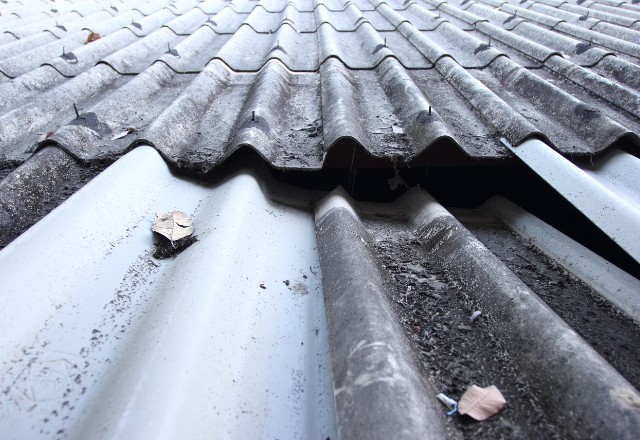
Signs You Have a Roof Leak
Detecting issues early is crucial to minimize roof repair costs and prevent water from causing additional ceiling, wall, insulation and even structural damages. Be on the lookout for these common warning signs:
- Water Spots on Ceiling: One of the most obvious signs of a roof leak is water spots or stains on your ceiling. These spots might appear brownish or yellowish and grow in size after a rainstorm.
- Peeling Paint: If you notice paint peeling off your walls or ceiling, especially near where the wall meets the ceiling, it could indicate moisture from a roof leak.
- Mold or Mildew Growth: The presence of mold or mildew, particularly in your attic space or along exterior walls, can be a sign of a leaky roof. Moisture trapped in these areas creates a perfect environment for mold growth.
- Puddles on the Roof After Rain: After a rainstorm, check your roof for puddles of water or water pooling in certain areas. This can indicate poor drainage or a sagging roof deck, both of which can lead to leaks.
- High Utility Bills: Surprisingly, a leaky roof can impact your home’s energy efficiency. If you notice a sudden spike in your utility bills, it could be due to air escaping through breaches in your roof, forcing your heating or cooling system to work harder.
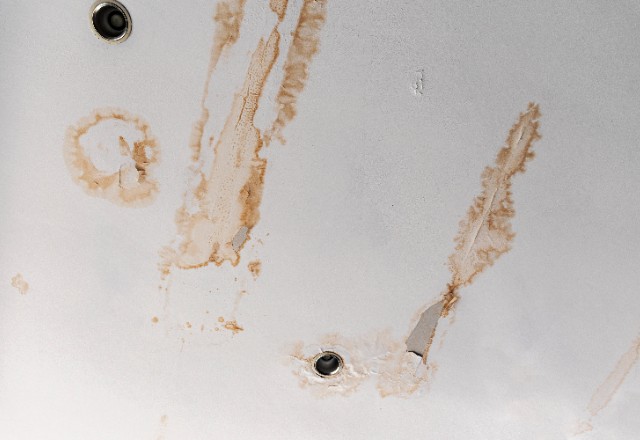
Dangers of Ignoring Roof Leaks
It can be tempting to put off dealing with leaks, but this often leads to exponentially worse issues down the line. Left unchecked, small drips can lead to thousands in repairs and replacements. On the contrary, standard gutter check-up or small repairs for around $50 can solve the issue before it escalates. Water infiltration causes destructive damage over time. Ignoring roof leaks can lead to a cascade of problems, some of which can be costly and hazardous:
- Destructive Water Damage: Continuous water intrusion from a leaky roof can cause significant damage to your home’s interior, including ceilings, walls, and floors. Over time, this can lead to the weakening of structural elements like joists and beams, especially if the leak reaches the attic space.
- Promotion of Mold Growth: Moisture is a breeding ground for mold and mildew, which can spread rapidly throughout your home. Mold not only damages your property but can also pose serious health risks, especially to those with allergies or respiratory issues.
- Compromised Structural Integrity: Prolonged exposure to water can weaken the structural integrity of your home. This includes damage to the roof decking and the roof’s support structure, which can lead to costly repairs or even roof collapse in severe cases.
- Risk of Injury from Falling Debris: In cases of severe leaks, parts of the ceiling or roof materials may become so damaged that they fall, putting your family at risk of injury.
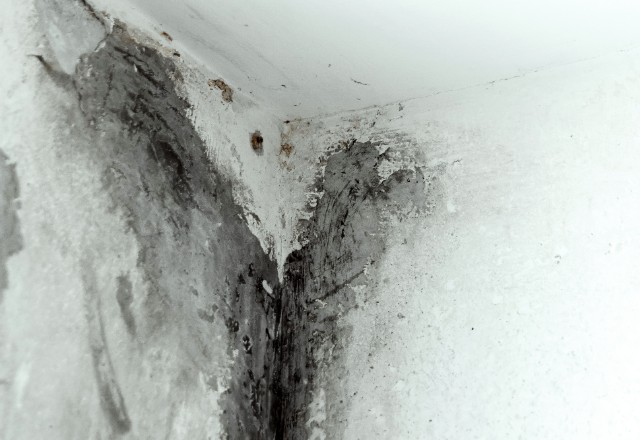
Temporary Roof Leak Repairs
In an emergency, you may opt to try temporary repairs until professional roofing services can provide comprehensive long-term solutions. While some leaks require professional attention, there are temporary fixes that homeowners can undertake to mitigate damage.
- Locate Source of Leak: Identifying the exact location of the leak is the first step. This might involve inspecting the roof for obvious signs like broken shingles, puncture holes, or damaged flashing.
- Remove Debris from Affected Area: Check for debris impact on the water flow, interrupting proper drainage. This includes cleaning gutters and downspouts.
- Seal Leaks Using Caulk, Sealant, Tar: For small leaks, apply roofing caulk or sealant to the affected area. For metal roofs, use a specialized sealant designed for metal.
- Create Drainage for Water to Safely Exit: If there’s water pooling, create a temporary path for the water to drain off the roof, preventing further accumulation.
- Install Protection Layers Over Affected Areas: In some cases, installing a tarp or other protective layering can provide a temporary barrier against water ingress.
Professional Roof Leak Repair Services
Investing in comprehensive roof repairs performed to manufacturer specifications gives you the best shot at tackling problems at their core while restoring peak performance, safety and storm resilience. For long-term solutions, professional roofing services are recommended:
- Thorough Inspection to Identify All Leaks: A professional roofing contractor will conduct a comprehensive inspection to identify all areas of leakage and potential future issues.
- Repair and Replacement of Damaged Materials: This includes replacing broken shingles, repairing damaged roof decking, and ensuring all roof joints and valleys are properly sealed.
- Improve Drainage and Ventilation: Professionals can enhance the roof’s drainage system and improve ventilation to prevent future leaks.
- Long-term Solutions to Prevent Reoccurrence: This might involve a complete roof replacement or significant repairs, depending on the extent of the damage. The goal is to provide a permanent solution that safeguards the roof against future leaks.
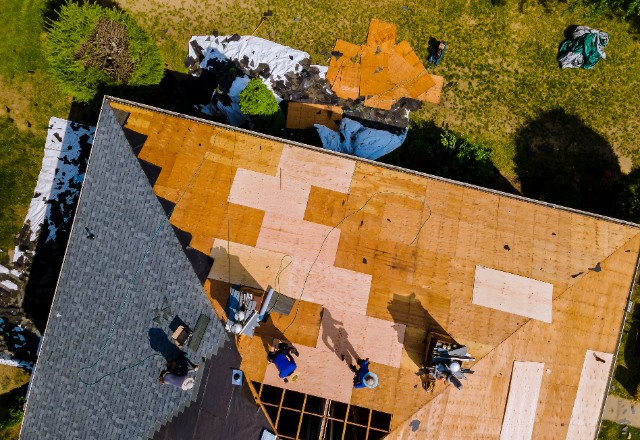
Choosing the Right Roofing Company
Selecting a competent roofing company is crucial for effective and lasting roof repairs:
- Licenses, Insurance, Qualifications: Ensure the roofing company is licensed and insured. This protects you from liability and guarantees that the company meets industry standards. Check their qualifications and certifications to ensure they are equipped to handle your specific roofing needs.
- Experience with Leak Repairs: Look for a company with extensive experience in repairing the type of leaks and range of materials they work with. Experience with metal roof leak repairs, flat roofs, and complex roofing systems is particularly valuable.
- Responsive to Emergencies: Choose a company that offers emergency roof repairs. Quick response is crucial in preventing further damage, especially in cases of severe leaks or after a natural disaster.
- Affordable Pricing and Financing: Compare quotes from different companies. While cost shouldn’t be the only factor, it’s important to choose a company that offers fair, transparent pricing and, if necessary, financing options. If the company cooperates with insurance provider, it’s also a plus.
- Positive Reviews: Check for customer reviews and testimonials. Positive feedback from previous clients is a good indicator of reliability and quality of service.
Maintaining Your Roof to Prevent Leaks
Regular maintenance is key to preventing roof leaks:
- Inspect Roof 1-2 Times per Year: Conduct routine roof inspections to catch potential problems early. This is especially important after extreme weather events.
- Clear Debris and Leaves Regularly: Keep your roof surfaces and gutters clean to prevent water pooling and ensure proper drainage.
- Check Flashings, Vents, Skylights: These are common areas for leaks. Ensure they are sealed properly and in good condition.
- Replace Aging or Damaged Materials: Don’t wait for a leak to appear, especially if you notices missing pieces in a row of shingles or cracked tiles. Proactively replace worn or damaged shingles, tiles, or other roofing materials.
- Hire a Roofer for Preventative Roof Maintenance: Consider scheduling regular roof maintenance checks with a professional roofing contractor to ensure your roof remains in optimal condition.
When to consider roof replacement instead of repair?
When deciding whether to opt for roof replacement instead of repair, several factors need to be considered. The decision largely depends on the extent of the damage, the age of your roof, and the cost-effectiveness of repairs versus replacement. Here are key points to consider:
Extent of Damage:
- Minor Repairs: If the damage to your roof is minimal, such as a few missing shingles or minor leaks, repairs are usually sufficient. These types of damages can often be fixed quickly and at a lower cost.
- Major Leaks and Extensive Damage: When your roof has major leaks or extensive damage, a complete repair might not be enough. In cases where the structural integrity of the roof is compromised, or there are widespread issues, replacing the entire roof is often more practical and safer for a hassle-free and long-lasting roof.
Age of the Roof:
- The lifespan of a roof ranges depending on the materials used. For instance, a shingle roof typically lasts about 20-25 years. If your roof is nearing the end of its expected lifespan and experiencing problems, replacing it might be more cost-effective than ongoing repairs.
Cost Considerations:
- Roof Leak Repair Cost vs. Replacement Cost: Evaluate the cost of repairing the leaks, including labor costs and materials. Sometimes, the cost per square foot for repairing a large area can reach thousands of dollars. The cost of a new roof in such a case is worth considering.
- Long-Term Savings: While the initial investment for a roof replacement can be significant, often running into thousands of dollars, it might save you money in the long run. Frequent repairs add up, and a new roof can offer more durability and less need for repairs.
- Labor Costs: Consider that complex roofs might require more labor for repairs, which can increase the overall cost. In such cases, replacement might offer a more straightforward and cost-effective solution.
Future Issues:
- Preventing Future Problems: A new roof can provide peace of mind, knowing that you are less likely to face future issues. It can also come with a warranty, offering protection against potential problems.
- Common Solution for Aging Roofs: For older roofs that have been repaired multiple times, replacement is a common solution. It eliminates the cycle of continuous repairs and the associated costs.
Roof replacement should be considered when repairs are no longer cost-effective or when the roof’s age and eventual water damage suggest that future issues are likely. While the upfront cost of a roof replacement can be high, it might be a more economical and practical solution in the long term, especially for complex roofs or those with major leaks and extensive damage.

What roofs are more prone to leaks?
Certain types of roofs are more prone to leaks due to their design, materials, and the way they interact with environmental elements. Here’s a look at some roof types that often require more attention to prevent leaks:
1. Metal Roofs: Metal roofs are generally durable, but the metal roof valleys, where two slopes meet, can be vulnerable to leaks. Water can accumulate in these valleys, leading to corrosion or breakdown of the sealant over time.
2. Aluminum Roof: While aluminum roofs are known for their longevity and resistance to corrosion, they can still develop leaks, especially if the installation was not done correctly or if the sealant around the fasteners deteriorates.
3. Cedar Shingle Roof: Cedar shingles offer a beautiful, natural look but are more prone to leaks compared to other materials. They can warp, crack, or become loose over time, especially if not properly maintained, allowing water to seep through.
4. Clay Roof: Clay roofs are popular for their aesthetic and durability. However, they can be susceptible to leaks, particularly if individual tiles crack or the flashing is not properly installed or maintained.
5. Copper Roof: Copper roofs are long-lasting and durable, but they can develop leaks over time, especially in the seams and joints. The expansion and contraction due to temperature changes can cause these areas to become vulnerable.
6. Composite Roof: Composite roofing materials mimic the look of natural materials but can be prone to leaks if not properly installed or if they suffer impact damage from debris or hail.
7. Dormer Roof: Roofs featuring dormers not only provide additional space but also have more complex structures with additional seams and joints, which can be potential points for leaks. The intersection between the dormer and the main roof needs to be properly sealed to prevent water intrusion.
What are the weakest roof elements prone to leaks and why?
Certain elements of a roof are more prone to leaks due to their design, location, and the functions they serve. Understanding these weak points can help in early detection and prevention of common roof leaks. Here are some of the most vulnerable roof elements:
1. Metal Roof Valleys: The valleys in metal roofs, where two slopes meet, are common sites for leaks. Water tends to collect in these areas, and if the sealant or flashing is not properly installed or has deteriorated, it can lead to leaks.
2. Roof Nail Leak: Leaks can occur around roofing nails, especially if they become loose or if the sealant around them has failed. Over time, the constant expansion and contraction of the roof can cause nails to protrude, compromising the watertight seal.
3. Roof Openings: Any opening in the roof, such as those for chimneys or skylights, is a potential weak point. These areas require careful sealing and flashing to prevent water intrusion.
4. Roof Vent Pipes: Vents are essential for proper attic ventilation, but the areas around roof ventilation pipes are susceptible to leaks. Faulty or aged seals, or damaged flashing around these pipes, can allow water to seep through.
5. Roof Valley Leaks: Similar to metal roof valleys, any roof valley is a potential leak point. Debris accumulation, improper installation, or worn-out materials in these valleys can impede water flow, causing it to back up and seep under the shingles.
6. Faulty Seal: A common cause of roof leaks is a faulty seal around roof elements. Over time, seals can dry out, crack, or shrink, losing their effectiveness and allowing water to penetrate the roof.
7. Skylight Leaks: Skylights add natural light but are also common leak sites. The intersection between the average skylight and the roof is particularly vulnerable, especially if the flashing is not correctly installed or if the skylight’s seals have failed.
The weakest elements prone to leaks are those where there is a break or join in the roofing material—such as valleys, openings for fixtures like skylights and vents, and points of fastening like nails. These areas are susceptible due to the challenges in maintaining a watertight seal, the potential for damage or deterioration over time, and the concentration of water flow, which can exacerbate any existing vulnerabilities. Regular inspection and maintenance of these key areas can help prevent leaks and extend the life of your roof.
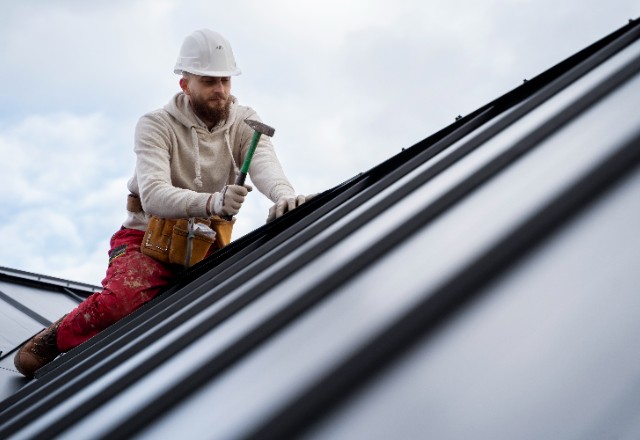
What’s the Real Roof Leak Repair Cost?
Understanding the real cost of roof leak repair is crucial for homeowners facing the telltale signs of a damaged roof, such as drops of water coming through the ceiling. This section delves into the various factors that influence repair costs, including age-related replacement issues and the cost of labor. We’ll provide a comprehensive overview to help you gauge what you can expect to invest in preserving the integrity of your roof.
What Influences Roof Leak Repair Cost?
Several factors influence the cost of roof leak repair, and understanding these can help you anticipate the expenses involved. Here’s a breakdown of what affects the cost:
Roof Size and Shape
- Roof Size: Generally, the larger the roof, the higher the cost of repair. Costs are often calculated per square foot, so a larger roof area increases the overall project cost. Repairing entire roof is costlier than patching small issues.
- Roof Shape: Complex roof shapes can increase the cost due to the difficulty of the repair. For example, a roof with multiple valleys or steep pitches may require more time and labor.
Type of Roof and Materials
- Shingle Type and Roof Material: The cost can vary depending on the type of shingles (e.g., asphalt, wood, tile) or roofing material. Specialty roof materials like wood roofs or thermoplastic polyolefin (TPO) for flat roofs can be more expensive to than sheet metal roof repair.
- Flat Roof Leak Repair: Flat roofs may require different repair techniques and materials, influencing the cost.
- Roof Pitch: The roof pitch directly impacts leak repair costs, as steeper roofs require more safety measures and specialized techniques, increasing labor costs. Flatter roofs, being easier to access and navigate, typically result in lower repair expenses due to simpler repair methods.
Extent and Nature of Damage
- Minor vs. Major Issues: Minor issues like a few leaks from debris punctures may cost less to repair compared to major structural damage or extensive leaks requiring entire roof repair or even replacement.
- Hole Size: The size of the puncture or damaged area plays a significant role. A larger hole or puncture requires more materials (eg. more extra shingles) and labor, increasing the cost.
- Leaks Origin: The source of the leak also affects the cost. For example, leaks around chimneys or skylights may be more complex and costly to fix.
Labor Costs
- Hour for Labor: Labor rates vary by region and the expertise of the roofing professionals. Specialized roofing contractors may charge more, but their expertise can provide a more effective and long-lasting solution.
- Project Complexity: A larger project or one that requires specialized skills (like working on a uniquely shaped roof) can increase labor costs.
Additional Factors
- Type of Repair: The specific repair method (e.g., patching a hole, replacing shingles, resealing a vent or improving other roof locations) can influence the cost. Partial or entire roof repair also matter.
- Linear Foot: Some repairs are priced by linear foot, especially when dealing with features like gutters or flashing. The average gutter cleaning cost is between 150–200 dollars.
The average cost of roof leak repair is influenced by the roof’s size and shape, the type and extent of damage, the materials involved, labor rates, and the specific nature of the repair required. It’s important to consult with roofing professionals to get an accurate estimate based on these factors. Remember, while opting for a less expensive solution might be tempting, ensuring a quality repair can save you from bigger issues and costs in the long run.
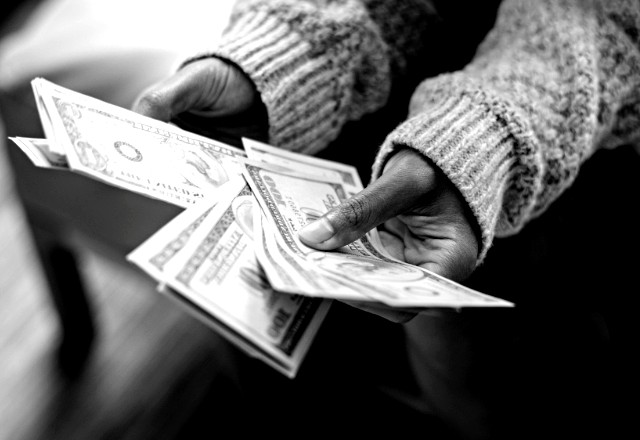
How Roof Material Influences Leak Repair Cost
Let’s break down typical leak repair costs for the most popular roofing materials:
Asphalt Shingle Leaks – $240 to $850
Asphalt shingle leaks may occur due to improper nailing, cracks, or missing tabs. Fixes involve renailing loose areas or replacing damaged sections with replacement shingle. If more than 50 sq. ft. are impacted, entire roof replacement may be needed.
Composite Roof Repairs – $250 to $2000
Roof materials like synthetic slate, laminated shingles, and rubber may leak from similar issues. Composite roof leaks require replacing broken, lifted or missing pieces. Extensive damage over 50 sq. ft. warrants roof replacement.
Slate Roof Leak Repair – $300 to $1400
Leaks usually stem from missing or broken slate tiles damaged by weather and debris. Repairs involve replacing damaged shingles. Flashing leaks due to age and deterioration may require more extensive repairs.
Metal Roof Leak Repair – $500 to $2200
Punctures, gaps from contraction, loose fasteners, and aging can lead to leaks. Fixes involve securing hardware, sealing openings, or replacing panels. More complex metal roof materials increase costs.
Wood Roof Leak Repair – $650 to $2300
Rotting and leaks often occur around flashings and joints. Shingles, shakes, and flashings must be replaced. Swift action minimizes further water damage.
Clay Tile Leaks – $800 to $2500
Cracks and broken sections are common leak points. Repairs require replacing and reinstalling affected areas – a bigger endeavor than standard leak fixes. Choose clay tiles for their longevity.
While all roofs can potentially develop leaks, those with more complex structures, such as dormer roofs or roofs with valleys, and those made from natural materials like cedar or clay, tend to be more susceptible. Regular inspection and maintenance are key to preventing leaks, regardless of the roof type.
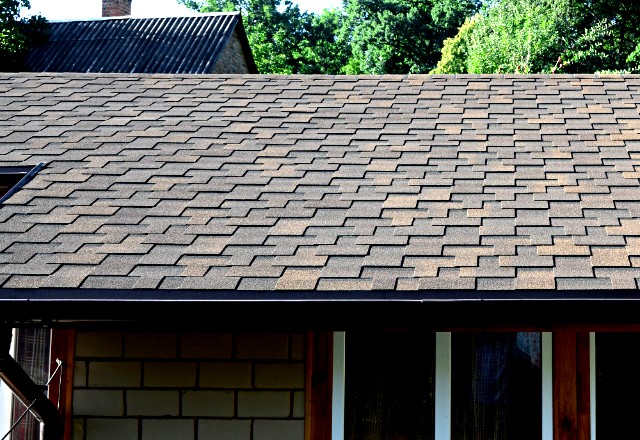
How Source of Problem Influences Leak Repair Cost
In this section we are going to provide TOP-10 roofing issues that require repairing as well as average costs for these services:
- Sealing Roof Valleys: Sealing leaking roof valleys costs $370 to $700. Valleys collect water so proper seals prevent penetration during initial installs.
- Improperly Nailed Shingles: Renailing improperly attached shingles runs $220 to $800 depending on quantity. Removing and properly renailing crooked nails that allow water intrusion fixes issues.
- Hole Repairs: Holes cost $140 to $5,000 to repair based on size and depth. Small holes need patches while holes exposing the roof deck require replacing sections and reshingling. Spanning multiple sections raises costs.
- Skylight Leak Repairs: Fixing improperly installed, leaking skylights averages $450 to $750. Solutions involve resealing and correctly flashing around the unit.
- Cracked Vent Boot Repairs: Vent boot issue may need costly repairs. Fixing cracked vent boot seals costs $240 to $380. The rubber boot that seals roof vents can become brittle and crack over time, requiring replacement.
- Damaged Shingle Repairs: Fixing damaged shingles runs $240 to $2,200 based on quantity and type. Cracked, curled or lifted shingles allowing water infiltration must be removed and replaced.
- Flashing Repairs: Fixing cracked or missing flashing costs $320 to $1,100. Flashing seals roof protrusions but may crack or detach, requiring replacement.
- Leaking Chimney Repairs: Fixing older, leaking chimneys costs $510 to $4,600 depending on damage. Solutions range from resealing to full repairs.
- Removing Ice Dams: Eliminating ice dams costs $500 to $1,700 based on size. Ice and water buildup forces water under shingles and leads to damage.
- Unclogging Gutters: Clogged gutters cost $120 to $250 to unclog. Buildup can cause water to back up, leading to leaks, especially around roof valleys. Having gutters cleaned prevents future damage.
Popular roofing services for leaky issues and their costs
Clearing Clogged Rain Gutters
Unclogging and cleaning gutters runs from $110-120 and depends on length. Gutters should be professionally flushed 1-2 times per year to enable drainage and prevent overflow damage. Routine cleaning removes leaves, dirt and debris that can otherwise lead to leaks or detachment.
Applying Leak Patches
Patching roof leaks costs $170 to $2,300 based on size and placement. Patching involves replacing missing shingles, flashings or seals with new materials. Small shingle patches are cheaper while patching large holes or sections is more extensive.
Re-Caulking Chimneys
Re-caulking leaky chimneys averages $350 to $600. With time, chimney caulk can crack or fall out, requiring replacement to seal the masonry-roof border. Costs vary by chimney size.
Metal Roof Repair
Fixing punctures, gaps and leaks on metal roofing runs $450 to $2,200 on average. Copper and zinc are more expensive than steel. An experienced metal roofing contractor is key for quality results.
Sealing A Roof
Professionally sealing a leaky roof costs $550 to $2,800 depending on area size. Targeted problem spots like protrusions may need re-sealing, or entire roof re-seals may be warranted for full protection.
Ice Dam Removal
Winter ice dam removal averages $500 to $1,700, depending on size and severity. Built-up ice prevents drainage, overloads roofs, and leads to extensive leakage damage if left unaddressed.
Full Roof Replacement
Installing a completely new roof costs $7,500 to $35,000 based on materials, area size and complexity. If widespread leaks or damage exceed 100 sq ft, replacement is often the best long-term solution.
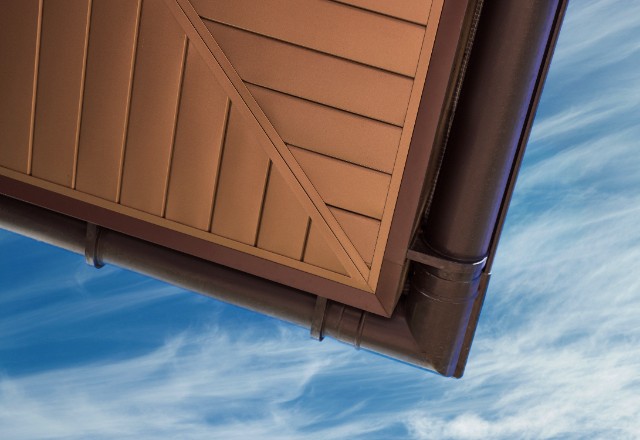
Can insurance cover roof leak repairs?
Insurance can cover roof leak repairs, but it largely depends on the cause of the leak and the specifics of your insurance policy. Here’s a brief overview:
Insurance Policy: Your homeowner’s insurance policy typically covers leaky roof repairs if the damage is caused by a sudden and unforeseen event, like a storm or vandalism. It’s important to review your policy to understand what is and isn’t covered.
Insurance Company and Provider: Contact your insurance provider as soon as you notice a roof leak. They will guide you through the process of filing an insurance claim.
Insurance Claim: When filing a claim, you’ll likely need to provide evidence of the damage and the cause. The insurance company may send an adjuster to assess the damage and determine if the repair costs will be covered.
Cost of Roof Repair: The cost of repairing a leaky roof can vary widely depending on the extent of the damage. Your insurance may cover the full cost or only a portion, depending on your policy’s terms and the deductible amount.
Wide Range of Coverage: Policies can vary significantly, so it’s essential to understand the specifics of your coverage. Some policies might cover the full replacement of a damaged roof, while others may only cover repairs.
In summary, whether insurance covers roof leak repairs depends on the cause of the damage and your specific insurance policy. It’s crucial to understand your coverage and work closely with your insurance provider to navigate the claim process.
Conclusion
Understanding the causes and signs of roof leaks, the dangers of ignoring them, and knowing both temporary and professional repair solutions are essential for maintaining the health and safety of your home.
Roof leaks should never be ignored. Catching and repairing them swiftly saves homeowners from ceiling collapses, black mold infestations and astronomical repair bills. Arm yourself by recognizing common causes, actively checking for early warning signs, and partnering with seasoned roofers to offer reliable solutions.
Don’t become another statistic with a flooded dining room or detached shingles crushed your car – take action by contacting Advance roofing LLC today for an inspection and quote. Get ahead of leaks for roof health and household peace of mind.
Expert answers to Frequently Asked Questions on Roof Leak Repair Services
Is a leaking ceiling an emergency?
What do roofers use to seal cracks?
How much does it cost to put sealant on a roof?
Can all roof leaks be fixed?
Will roof tar stop leaks?
How much water comes off my roof when it rains?
Can you fix a leak while it's raining?
How do you fix a leaking shingle roof?
Do you repair only residential roofs?
Why are roof inspections so important in preventing water leaks?
Disclaimer: The information provided in this article about roof leak repair and associated costs is intended for general guidance only. It should not be considered as professional advice for specific roofing issues. Every roofing situation is unique, and factors such as roof size, material, and extent of damage can significantly affect repair costs. For personalized advice tailored to your specific circumstances, we highly recommend consulting with experienced professionals. Please visit Advance Roofing LLC for expert consultation – our team is always eager to assist you with your roofing needs. For many years, Advance Roofing LLC has been dedicatedly serving the Spokane, WA area, offering top-notch roofing solutions characterized by exceptional quality and reliability.



 509-201-4190
509-201-4190
